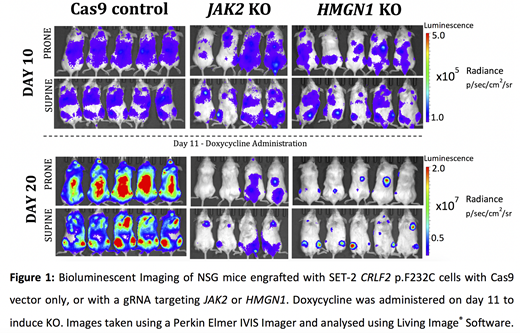Introduction
Down Syndrome (DS) patients are at high risk of developing hematological malignancies and ~10% are born with a pre-leukemic disorder characterised by the overproduction of immature megakaryoblasts. Children with DS have a 20-fold increased risk of developing acute lymphoblastic leukemia (ALL) of which 60% are associated with high expression of cytokine receptor like factor 2 (CRLF2) and of these, ~9% acquire the aggressive CRLF2 p.F232C mutation. DS-ALL children also experience high treatment toxicity and high relapse rates compared to non-DS leukemia patients. Genes on chromosome 21 including the high mobility group nucleosome-binding domain-containing protein 1 (HMGN1) are likely to play a role in DS leukemogenesis and may be targets for a personalized treatment approach. We aimed to determine if HMGN1 is necessary for leukemic cell proliferation using an inducible CRISPR/Cas9 guide (g)RNA murine xenograft model.
Methods
A DS leukemic cell line model was created using the human trisomy 21 megakaryoblastic SET-2 cell line harboring JAK2 p.V617F; the only trisomy 21 leukemic cell line currently available. SET-2 cells were transduced with CRLF2 p.F232C to model an aggressive DS-ALL mutation. NOD.Cg-Prkdcscid,Il2rgtm1Wjl/Szj (NSG) mice were each injected with 3x105 SET-2 CRLF2 p.F232C CRISPR/Cas9 cells expressing luciferase in 3 groups; Cas9 only control, HMGN1 gRNA, or JAK2 positive control gRNA.
Doxycycline was administered post leukemic engraftment to induce the gRNAs and create a knockout (KO) and leukemic burden was monitored by bioluminescent imaging (BLI) twice weekly for the remainder of the experiment. Once Cas9 control mice became moribund, they were culled along with 50% of the JAK2 or HMGN1 KO mice and complete blood counts were performed. Bone marrow (BM), spleen and liver sections were stained with hematoxylin and eosin (H&E) and survival analysis was carried out for remaining JAK2 or HMGN1 KO mice. RQ-PCR was used to detect HMGN1 expression levels in KO mice organs at endpoint and DNA was extracted from cells harvested from each organ to undertake a gene editing analysis.
Results
Leukemic engraftment in mouse BM was observed 10 days post transplant with a radiance signal of ~1 x 104p/s/cm2/sr, therefore gRNAs were induced on day 11. On day 20, a significant reduction in tumor burden was detected in JAK2 and HMGN1 KO mice compared to Cas9 control mice (Fig. 1, Cas9: 8.4x105±1.7x105; JAK2 KO: 2.7x104±8.9x103; HMGN1 KO: 1.5x105±1.7x104 p/s/cm2/sr, prone: p<0.001, supine: p=0.005).
Blood counts at day 35 indicated similar white cell counts across Cas9, JAK2 and HMGN1 KO mice, however, the Cas9 mice demonstrated thrombocytopenia and anemia (platelet count: 705±43 K/µL, HCT: 22.5±2%) which was rescued in JAK2 and HMGN1 KO mice (JAK2 KO platelet count: 3046±775 K/µL, p<0.001; HCT: 47±6.8%, p=0.002; HMGN1 KO platelet count: 1503±83 K/µL, p<0.001; HCT: 38±3.4%, p=0.004). JAK2 and HMGN1 KO mice had reduced spleen weight (JAK2 KO: 46±2 mg, p=0.019; HMGN1 KO: 51±6 mg, p=0.046; Cas9: 81±7 mg) and liver weight compared to Cas9 control mice.
Megakaryoblast infiltration identified with H&E staining was evident in the BM, spleen and liver of Cas9 control mice, whereas megakaryoblasts were not observed in JAK2 or HMGN1 KO mice organs. Similarly, RQ-PCR demonstrated a 24% decrease in HMGN1 expression in the BM, 99% in the spleen and 92% in the liver; and a 38% decrease in JAK2 expression in the BM, 99% in the spleen and 70% in the liver of HMGN1 and JAK2 KO mice respectively compared to Cas9 control mice.
Significantly, survival analysis of the remaining JAK2 and HMGN1 KO mice indicated a substantial survival advantage from 35 days (Cas9) to 62 and 56 days respectively for JAK2 and HMGN1 KO mice (p=0.0009).
Conclusion
Our CRISPR/Cas9 DS leukemic xenograft HMGN1 KO model demonstrates the important role of HMGN1 in CRLF2 p.F232C DS leukemia. Significantly, HMGN1KO decreased the leukemic burden of mice to the same extent as the JAK2 (SET-2 driver gene) KO. The HMGN1 KO mitigated ALL phenotypes including hepatosplenomegaly, anemia and thrombocytopenia, preventing leukemic progression and resulting in a significant survival advantage over Cas9 control mice. As HMGN1 has a distinct role in proliferation and survival of DS leukemic cells, it is a potential candidate for targeting with a pharmacological inhibitor as a personalized treatment for DS leukemia patients.
White:Bristol-Myers Squibb: Honoraria, Research Funding; Amgen: Honoraria.
Author notes
Asterisk with author names denotes non-ASH members.


This feature is available to Subscribers Only
Sign In or Create an Account Close Modal